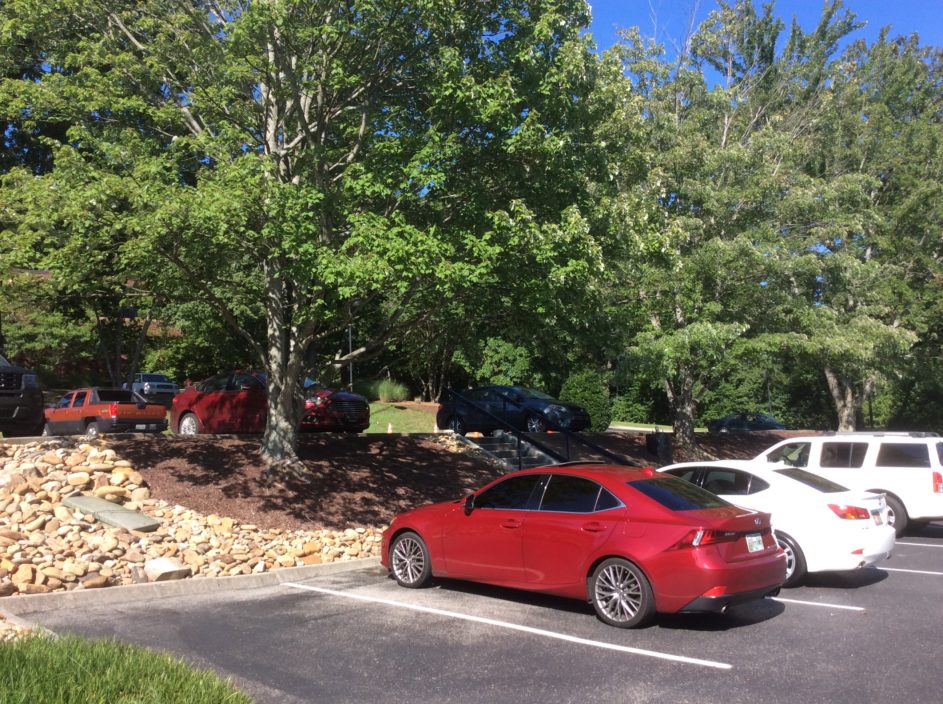(Note: This article has been updated at the request of Joyce Feld)
Last spring Scenic Knoxville put together a landscaping coalition that included representatives from Trees Knoxville, the City Tree Board, the Knoxville Chapter of the Society of Landscape Architects (ASLA) and the Harvey Broome chapter of the Sierra Club. They came up with a document that has been shared with Knox Planning (the former MPC) and its executive director, Gerald Green, and staff in hopes of helping to shape landscaping requirements under Recode Knoxville.
 According to Joyce Feld, president of Scenic Knoxville and a board member of Trees Knoxville, their suggestions have not been incorporated as of yet. The Scenic Knoxville coalition has been recruiting endorsements from neighborhood associations and other community organizations throughout the city. So far those include Town Hall East, Forest Heights Neighborhood Association, Community Forum and The Bearden Village Council. The list is growing.
According to Joyce Feld, president of Scenic Knoxville and a board member of Trees Knoxville, their suggestions have not been incorporated as of yet. The Scenic Knoxville coalition has been recruiting endorsements from neighborhood associations and other community organizations throughout the city. So far those include Town Hall East, Forest Heights Neighborhood Association, Community Forum and The Bearden Village Council. The list is growing.
Some of the concepts in the coalition’s document were in the first few drafts of the parking ordinance passed in 2017 by City Council but have been removed or diluted, Feld says.
“None of these ideas are radical,” she says. “Many cities have more demanding standards.”
As it stands now, interior landscaping requirements will affect only new parking lots of 20,000 square feet or above. That will leave seas of asphalt throughout the city.
“There are many reasons to have landscaping and add tree plantings,” says Feld. “Trees offer all kinds of benefits – aesthetic, economic.”
Feld provided the coalition’s document to KnoxTNToday for us to share with the public:
LANDSCAPING STANDARDS – Recode Knoxville
Many great cities have landscaping standards that are much stricter than the ones proposed in Recode. We know from their experiences that these standards are not overly onerous either to carry out or to enforce. Knoxville can and should do this, too. There are numerous environmental, economic, aesthetic and quality-of-life benefits to enhanced landscaping. We believe the following standards should be included in the new ordinance.
Interior Landscaping of New Parking Lots
The current parking ordinance allows for reduced or no perimeter or interior landscaping for lots smaller than 20,000 square feet. All lots larger than 5,000 square feet should be required to have some perimeter landscaping. Lots between 10,000 and 20,000 square feet should be required to have graduated interior landscaping (smaller and/or fewer islands), depending on the size of the lot.
Lots larger than 20,000 square feet should have a landscaping break every 10 spaces rather than every 15 spaces.
Landscape Bond:
In order to ensure correct installation and maintenance of landscaping, a two-step Landscape Bond should be required. Other cities successfully employ this process.
- Performance Bond: This allows developers six months after issuance of the Certificate of Occupancy to install landscaping to offset the disadvantage of completing projects in late spring or summer months to maximize reasonable growth conditions.
- Maintenance Bond: This would be applicable during the two-year period following the project’s completion and would include a reasonable time period for proper landscape care to assure healthy plant material. The Maintenance Bond is released after two years, contingent on satisfactory inspection by a qualified professional familiar with the design intent. Without a maintenance bond a lot of landscaping will not be adequately cared for and will die. Two years of proper care will greatly increase the survival of installed landscaping.
Since the city operates on a complaint-driven system and is chronically short staffed when it comes to enforcement, we don’t have a lot of confidence that it will be successful at requiring developers to replace landscaping that has died. It also places an unfair burden on citizens, who would be responsible for tracking and reporting landscaping that needs to be replaced. In our experience, this often requires multiple follow-up phone calls and emails by the citizen.
Mitigation Fund or Tree Bank
Recode should include some form of mitigation for the destruction of trees by developers, or when it’s not possible to fulfill the required landscape standards. The ordinance could specify that for each tree over a particular diameter that’s destroyed or not planted as required, a value of the destroyed or unplanted trees would be established and the developer pay the equivalent value into a mitigation bank, with the city using the funds for tree planting or landscaping projects elsewhere. Kasey Krouse, urban forester, has agreed to administer a Tree Bank for the city.
For more information about endorsing the document or to contact Scenic Knoxville, visit their website.
Feld also provided this text graphic:
Benefits of Trees
Trees beautify our public spaces
Trees increase property values
Trees increase walkability by providing shade
Trees cool the ambient temperature up to 10˚ F
Trees reduce air-conditioning costs
Trees promote ground absorption of rainfall and reduce stormwater runoff
Trees reduce air pollution by absorbing pollutant gases
Trees block unsightly views and muffle noise
Trees encourage pride of place
Trees increase business revenue because shoppers stay longer in attractive and inviting commercial spaces
Beauty is Good for People and Business

